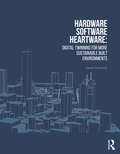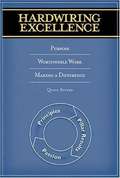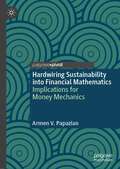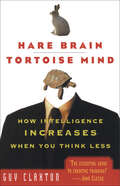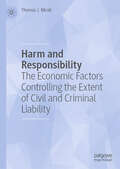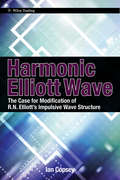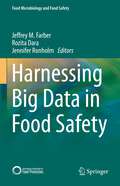- Table View
- List View
Hardware and Software Projects Troubleshooting: How Effective Requirements Writing Can Save the Day
by George KoelschLearn how to create good requirements when designing hardware and software systems. While this book emphasizes writing traditional “shall” statements, it also provides guidance on use case design and creating user stories in support of agile methodologies. The book surveys modelling techniques and various tools that support requirements collection and analysis. You’ll learn to manage requirements, including discussions of document types and digital approaches using spreadsheets, generic databases, and dedicated requirements tools. Good, clear examples are presented, many related to real-world work the author has performed during his career. More importantly, you will learn how these techniques can prevent the problems that occur during requirements development. Most of all, you will learn how good requirements governance will greatly increase the success of development projects by getting all people involved to eliminate the adverse impacts to requirements throughout the development lifecycle. Hardware and Software Projects Troubleshooting covers techniques for defining user needs, so you can determine which combination of approaches to use for your projects. You’ll also learn how to analyze the different development methodologies so that you can determine the advantages and disadvantages of different requirements approaches and implement them correctly as your needs evolve. Unlike most requirements books, this one teaches writing both hardware and software requirements because many projects include both areas. To exemplify this approach, two example projects are developed throughout the book, one focusing on hardware, and the other on software. What You Will Learn Focus on how to eliminate or mitigate requirements problemsUnderstand the 14 techniques for capturing all requirementsAddress software and hardware needs; because most projects involve bothEnsure all statements meet the 16 attributes of a good requirementDifferentiate the 19 different functional types of requirements, and the 31 non-functional typesWrite requirements properly based on extensive examples of good ‘shall’ statements, user stories, and use casesEmploy modelling techniques to mitigate the imprecision of wordsInstall requirements governance to significantly improve project success Who This Book Is For Requirements engineers who want to improve and master their craft, as well as students and those employed in government or other organizations at all levels.
Hardware, Software, Heartware: Digital Twinning for More Sustainable Built Environments
by Jason PomeroyThis richly illustrated book examines the full potential of Digital Twins (DTs) as a means of creating more sustainable urban habitats. It reveals how, in this digitally-enabled age, DTs are increasingly being adopted by cities as a tool for urban governance, with the hope of increasing operational efficiencies and enhancing citizens’ lives. While the study and implementation of DTs has been critically explored as virtual, dynamic 3D replicas of physical entities across different disciplines and industries, this book establishes a strategy that recognises the need for the ‘software’ behind virtual DT platforms to not only represent the ‘hardware’ of our physical cities but also to reflect the ‘heartware’ of socio-economic and cultural practices. Knowledge gaps and challenges in existing DTs are identified and insights into rethinking their purpose are provided to propose a new DT paradigm model for city-wide application. With multiple case studies illustrating the different concepts of DTs being applied in cities from Europe, North America, The Middle East, Asia and Oceania, the book highlights the reasons why and how DTs can play an integral role in the sustainability of our urban habitats. Beautifully designed and illustrated in full colour throughout, this book combines academic theory with practical application and will be a useful reference for professionals, students, academics and policymakers, working in the fields of smart cities, sustainable urbanism, and the digitisation, digitalisation and digital transformation of the built environment industry.
Hardwiring Excellence
by Quint StuderHardwiring Excellence offers a road map and practical how-to guide for creating and sustaining a culture of service and operational excellence. In this book, author Quint Studer, CEO of Studer Group, draws on his personal experience as a former hospital executive who led two organizations to the top 1% in patient satisfaction and his experience coaching hundreds of healthcare organizations since.
Hardwiring Sustainability into Financial Mathematics: Implications for Money Mechanics
by Armen V. PapazianA ground-breaking work that addresses a crucial challenge facing our planet and the finance discipline, this book discusses key omissions in finance theory, principles, and equations, and explores recent developments in sustainable finance/ESG integration. It reveals a spaceless analytical framework and a sustainability debate that avoids the very logic of money creation. A theoretical treatise on sustainability in finance, the book makes the case for the hardwiring of sustainability into financial mathematics, offering a complementary principle and new equations for the purpose, while also discussing the implications of such a transformation for money mechanics.
Hare Brain, Tortoise Mind: How Intelligence Increases When You Think Less
by Guy Claxton“Backs up anecdotal studies of creativity with up-to-date Information about the latest research into brain function . . . a fascinating book.” —Anthony Storr, author of Solitude: A Return to SelfIn these accelerated times, our decisive and businesslike ways of thinking are unprepared for ambiguity and paradox, and we’ve lost our appreciation for the value of “sleeping on it.” We assume that the quick-thinking hare brain will beat out the slower intuition of the tortoise mind. But new research in cognitive science is changing this understanding of human mental processes. It suggests that patience and confusion—not rigor and certainty—are the essential precursors of wisdom.With a compelling argument that the mind works best when we trust our unconscious, or “undermind,” psychologist Guy Claxton makes an appeal that we be less analytical and let our creativity have free rein. He also encourages reevaluation of society’s obsession with results-oriented thinking and problem-solving under pressure. Packed with interesting anecdotes, a dozen puzzles to test your reasoning, and the latest related research, Hare Brain, Tortoise Mind is an Illuminating, uplifting, stimulating read that focuses on a new kind of well-being and cognition.“The essential guide to creative thinking.” —John Cleese“His multidisciplinary approach is beautifully executed.” —Kirkus Reviews“Counterintuitive . . . provocative . . . While Claxton speaks the language of cognitive science, his ideas resonate with Freud’s description of the unconscious, Buddhist concepts of the divine ground of existence and the great Romantic poets’ notions of the fount of creativity.” —Publishers Weekly
Hariyali Kisaan Bazaar: A Rural Business Initiative
by David E. Bell Nitin SanghaviIn rural India, farmers historically had limited access to quality input items for both their fields and homes. Indian conglomerate DSCL has undertaken a Rural Business Initiative to address this issue, establishing a chain of retail outlets throughout rural India geared toward farmers and their families. Through its growing network of stores, DSCL is able to establish relationships with farmers and provide them with a host of agricultural services, including improved crop inputs, agronomic support, fuel, banking, and consumer goods. The outlets also buy back some of the farmers' production at harvest time. In utilizing the products and services offered by the stores, farmers are able to improve the quality of their crops and access a network of helpful resources in an environment that was once considered completely tangential to the benefits of agricultural research and technology reaped in other parts of the world. DSCL strategizes about how the company can also benefit from these freshly forged connections with India's rural millions.
Harlem Capital: Changing the Face of Entrepreneurship (A)
by George Serafeim David FreibergJarrid Tingle and Henri Pierre-Jacques had spent the summer between their first and second years of their Harvard Business School MBA program fund raising for their start-up Venture Capital (VC) firm, Harlem Capital Partners. Harlem Capital was founded upon the principle that addressing the VC funding gap for minorities and women - whom received only 3 percent of total VC funding - could produce superior returns. Tingle and Pierre-Jacques were passionate about the mission of Harlem Capital to change the face of entrepreneurship. However, despite generating significant media attention, Harlem Capital had only raised a few million dollars over the summer, not nearly enough for the fund to be financially viable to be a career path for Tingle and Pierre-Jacques. Should Tingle and Pierre-Jacques commit to Harlem Capital despite the serious roadblocks on their path? Or should they capitalize on their pre-MBA Private Equity experience and attempt to be impactful through a more traditional career post-MBA graduation?
Harlem Capital: Changing the Face of Entrepreneurship (B)
by George Serafeim David FreibergCase B describes Tingle and Pierre-Jacques' decision to commit fully to Harlem Capital as their post-graduation job. The case explores the results of their fundraising efforts, new strategic partnerships and how they plan to "build the market" in order to achieve future, sustained success in building funds comprised of diverse entrepreneurs.
Harlem Children's Zone: Driving Performance with Measurement and Evaluation
by Allen Grossman Daniel F. CurranGeoffrey Canada, CEO of the Harlem Children's Zone, wanted his organization to grow dramatically to reach thousands of poor and underserved children in Harlem. The agency ran a variety of successful social service programs throughout New York City that were separately funded and ran independently of each other. In 2000, Canada led the organization through an ambitious planning process, promising that within 10 years, its new integrated program would reach $46 million in revenues, serve 24,000 people, and expand to an area three times the size of its current zone. But the plan required the agency to change its management structure, measurement systems, and program goals drastically. How would the organization measure the impact of its work? Could such a system be measured? And how did the changes challenge the passionate directors who first established the component programs?
Harlequin Romances--Poland (A)
by John A. Quelch Nathalie LaidlerHarlequin Enterprises, the world's leading publisher of series romances, has been particularly successful in Poland. The case explores some of the challenges/opportunities of doing business in Eastern Europe and the marketing mix elements necessary for success.
Harley-Davidson Motor Co.: Enterprise Software Selection
by Robert D. Austin Mark Cotteleer Deborah SoleDescribes Harley-Davidson's decision process for defining and selecting an enterprise-wide procurement software package and the institutional changes introduced as part of this process. Tells the story of Harley-Davidson's approach in developing integrated business processes and information systems to meet the needs of a visionary procurement strategy. Central to this activity was the evaluation and selection of an enterprise software package and implementation partner to support the strategy. Describes managerial reasoning and tactics to introduce significant organizational change into a setting where team-based responsibility and a culture of autonomy are prominent.
Harley-Davidson in India (A)
by David Lane Krishna G. PalepuThis case examines how Harley-Davidson has worked to globalize its business by focusing on how CEO Matt Levatich and India country manager Anoop Prakash assess and act on the opportunities and challenges posed by entering the Indian market, and where and how the lessons they learn there are applicable elsewhere both geographically and within Harley-Davidson's organization.
Harley-Davidson in India (B)
by David Lane Krishna G. PalepuThis case examines how Harley-Davidson has worked to globalize its business by focusing on how CEO Matt Levatich and India country manager Anoop Prakash assess and act on the opportunities and challenges posed by entering the Indian market, and where and how the lessons they learn there are applicable elsewhere both geographically and within Harley-Davidson's organization.
Harley-Davidson, Inc.: Motorcycle Manufacturer or Financing Company?
by Jacob Cohen Gregory S. MillerHarley-Davidson manufactures and sells motorcycles. It also provides financing for retail purchases and dealer stock. Although Harley's performance has been very strong, analysts and the press have questioned its use of a special-purpose entity to sell securities collateralized by its financing activities. Harley's management must decide how to balance the street's suspicion of this activity with its strategy of providing a "whole motorcycle experience" and the high level of profits created by the current arrangement.
Harley-Davidson: Preparing for the Next Century
by Richard L. Nolan Suresh KothaHarley-Davidson Co. exemplifies a remarkable management-led business transformation of a long standing manufacturing company. The company successfully met global competition and continues to innovate to maintain its market position.
Harm and Responsibility: The Economic Factors Controlling the Extent of Civil and Criminal Liability
by Thomas J. MiceliRisk is an ever-present feature of life in a complex world, and it is important for societies to manage it in a just and efficient manner. One way to reduce risk is to assign responsibility for the associated harm. In this book, economist Thomas J. Miceli examines harm and responsibility from an economic perspective. The book focuses on how responsibility affects people’s incentives to refrain from causing unnecessary harm to achieve what economists call optimal deterrence. Secondarily, it is concerned with the quest for justice. Defining this is part of the journey. Does it mean compensating victims for unavoidable losses? Does it involve punishing wrongdoers in proportion to the harm they have caused? Is there a clear answer? The book addresses these questions and more, explaining how, in some cases, these objectives will align with deterrence and in others they will not. The book discusses the ways that the law, tempered by religious and social norms, strikes a balance between these goals. The principal areas of law that assign legal responsibility are tort law (for accidental harms) and criminal law (for intentional harms). There exist vibrant economic theories of both, and this volume draws on this literature. One theme that emerges is the role of causation in determining responsibility. Attributing responsibility for a given harm to the party that caused it seems both morally just (because it embodies personal responsibility), and economically desirable (because it achieves deterrence in the most direct manner). And yet the law departs from this prescription in any number of ways, both by limiting the responsibility of some who caused harm and by expanding responsibility to some who did not. The book offers readers coherent economic explanations for these departures from a purely causal basis for legal responsibility. Author Thomas J. Miceli clarifies causation as reciprocal in nature and therefore not a uniquely defined concept. This means that when an action by A causes harm to B, the question is not how to restrain A but rather: whether A has the legal right to take the action in question or whether B has the right to prevent it. There will be a harm either way; the relevant question is which party should bear it. This insight ultimately leads to the fundamental problem of defining harm. In most conflicts this can be straightforward—as when A punches B—but in others it is more challenging. For example, when does free speech become hate speech? Where is the line drawn? The book concludes by drawing out the implications of this fundamental ambiguity over the meaning of harm, what that means for the law, and what economic theory has to say about it.
Harmon Foods, Inc.
by William B. WhistonPrediction and shipment has been a scheduling and budgetary problem. Multiple regression is suggested as a solution. Evaluation of regression coefficients leads to better understanding of trend, seasonality, and promotion effectiveness.
Harmonic Elliott Wave
by Ian CopseyAn update to the Elliot Wave Principle that corrects a fundamental error The Elliot Wave Principle has been widely adopted as a tool for traders analyzing market cycles, but Ian Copsey has unearthed a fundamental error in the way it defines the structural development of price behavior. Harmonic Elliott Wave: The Case for Modification of R. N. Elliott's Impulsive Wave Structure explains what's wrong with the Principle, outlining a modification that allows for more accurate trading predictions. Revealing the methodology that led to this discovery, the common ratios that link different parts of the wave structure, and providing a wealth of practical examples to explain his findings, Copsey shows how waves really develop, dispelling the misconceptions that have been practiced by Elliotticians for years. Supporting his methods by consistently ensuring that waves are related by common ratios, Copsey helps the reader apply the revised version of the Principle with greater understanding and accuracy. Reveals a fundamental error in the popular Elliot Wave Principle Outlines a tried and tested modification that fixes this mistake and allows for more accurate analysis Offers essential information on applying the new model to the markets With far-reaching implications for traders everywhere, Harmonic Elliott Wave is a must-read for anyone who puts their faith in the Elliot Wave Principle.
Harmonic Hearing Co.
by Howard H. Stevenson Craig StephensonHarmonic is a small, privately held manufacturer of hearing aids. Harriet Burns and Marc Davis, two employees at Harmonic, have an opportunity to purchase the company from the founder. As well-informed insiders who understand the industry, Burns and Davis believe the benefits of ownership far outweigh the risks. While the decision to purchase Harmonic is easy for them, arranging financing proves more difficult. The company is preparing to launch a new hearing aid product and Burns and Davis want the financing package to include the additional capital required to complete both the development and the launch. Two financing alternatives are presented: one is virtually all debt-financed, the other all equity. The financing structure Burns and Davis select will have a significant impact on the products and future prospects of the company. Students must analyze the two financing alternatives, determine the advantages and disadvantages, and recommend the best option.
Harmonie Water: Refreshing the World Naturally
by John A. Quelch John L. TeopacoThe marketing director of Harmonie Mineral Water-the second-best selling bottled water in the world-is using findings from two project studies to assess how to establish a global brand identity for Harmonie via television advertising. He must decide what product attributes are sufficiently important across countries that they can be used for global brand communications. He also must determine the extent of local customization he should allow and the roles of headquarters and country managers in these communications. The case can be used in both introductory marketing classes and elective courses in Brand Management, Global Marketing, Integrated Marketing Communications, in a module on marketing communications in an Advertising class, or the global module of a Marketing Management class.
Harmonisation of EU Competition Law Enforcement
by Jurgita MalinauskaiteThis book explores how the EU’s enforcement of competition law has moved from centralisation to decentralisation over the years, with the National Competition Authorities embracing more enforcement powers. At the same time, harmonisation has been employed as a solution to ensure that the enforcement of EU competition rules is not weakened and the internal market remains a level playing field.While employing a comparative law argument, the book, accordingly, analyses the need for harmonisation throughout the different stages of development of the EU’s competition law enforcement (save Merger control and State Aid), the underlying rationale, and the extent to which comparative studies have been undertaken to facilitate the harmonisation process from an historical perspective. It also covers the Directives, such as the Antitrust Damages Directive and the ECN+ Directive. Investigating both public and private enforcement, it also examines the travaux préparatoires for the enforcement legislation in order to discover the drafters’ intent. The book addresses the European and the Member States’ perspectives, namely, the Central and Eastern European (CEE) countries, as harmonisation proceeds through dialogue and cooperation between the two levels. Lastly, it explores the extent to which harmonisation of the competition law enforcement framework has been accepted and implemented in the Member States’ legal systems, or has led to the fragmentation of the national systems of the CEE countries.
Harmonisierte Bestandsrechnung: Ein Ansatz zur unternehmensübergreifenden Produktsteuerung
by Enrico HandrickAusgangspunkt der vorliegenden Arbeit ist die Suche nach einem für die Unternehmenspraxis verwendbaren Instrument zur Steuerung und Koordination von Unternehmensverbundbeziehungen. Mit dem Ansatz der harmonisierten Bestandsrechnung leistet die vorliegende Forschungsarbeit einen Beitrag zur partiellen Integration der Rechnungswesensysteme auf der Produktebene. Es wird eine multidimensionale Vorratsbestandsrechnung beschrieben, die ein harmonisiertes Rechnungswesen ermöglicht, das sowohl für die Produktsteuerung bis hin zur Gesamtunternehmenssteuerung einschließlich der Steuerung von Unternehmensverbundsystemen genutzt werden kann. Basierend auf einem system-theoretischen und formalsprachlichen Fundament sowie unterstützt durch eine beispielhafte Anwendung in der Maschinenbau-Branche erfüllt die vorliegende Arbeit das Ziel, neben einer Angleichung der Bewertungs- und damit der Kosteninhalte, praktische Gestaltungsempfehlungen zum Aufbau eines einheitlichen Kostenrechnungssystems zu geben.
Harness Oil and Gas Big Data with Analytics: Optimize Exploration and Production with Data Driven Models
by Keith HoldawayUse big data analytics to efficiently drive oil and gas exploration and production Harness Oil and Gas Big Data with Analytics provides a complete view of big data and analytics techniques as they are applied to the oil and gas industry. Including a compendium of specific case studies, the book underscores the acute need for optimization in the oil and gas exploration and production stages and shows how data analytics can provide such optimization. This spans exploration, development, production and rejuvenation of oil and gas assets. The book serves as a guide for fully leveraging data, statistical, and quantitative analysis, exploratory and predictive modeling, and fact-based management to drive decision making in oil and gas operations. This comprehensive resource delves into the three major issues that face the oil and gas industry during the exploration and production stages: Data management, including storing massive quantities of data in a manner conducive to analysis and effectively retrieving, backing up, and purging data; Quantification of uncertainty, including a look at the statistical and data analytics methods for making predictions and determining the certainty of those predictions; Risk assessment, including predictive analysis of the likelihood that known risks are realized and how to properly deal with unknown risks. Covering the major issues facing the oil and gas industry in the exploration and production stages, Harness Big Data with Analytics reveals how to model big data to realize efficiencies and business benefits.
Harness the Power of the Purse: Winning Women Investors
by Andrea Turner MoffittWomen in the US exercise decision-making control over $11. 2 trillion of investable assets and 62% of women in the US, UK, China, Hong Kong, Singapore, and India identify as the primary source of household assets. Yet, a majority (53%) of female wealth in these markets is unmanaged by an advisor and, according to new research from the Center for Talent Innovation (CTI), closing the gap will require, in part, correcting industry perceptions of women as a monolithic market. The book, Harness the Power of the Purse: Winning Women Investors, draws a nuanced picture of female investors around the world.
Harnessing Big Data in Food Safety (Food Microbiology and Food Safety)
by Jeffrey M. Farber Rozita Dara Jennifer RonholmBig Data technologies have the potential to revolutionize the agriculture sector, in particular food safety and quality practices. This book is designed to provide a foundational understanding of various applications of Big Data in Food Safety. Big Data requires the use of sophisticated approaches for cleaning, processing and extracting useful information to improve decision-making. The contributed volume reviews some of these approaches and algorithms in the context of real-world food safety studies. Food safety and quality related data are being generated in large volumes and from a variety of sources such as farms, processors, retailers, government organizations, and other industries. The editors have included examples of how big data can be used in the fields of bacteriology, virology and mycology to improve food safety. Additional chapters detail how the big data sources are aggregated and used in food safety and quality areas such as food spoilage and quality deterioration along the supply chain, food supply chain traceability, as well as policy and regulations. The volume also contains solutions to address standardization, data interoperability, and other data governance and data related technical challenges. Furthermore, this volume discusses how the application of machine-learning has successfully improved the speed and/or accuracy of many processes in the food supply chain, and also discusses some of the inherent challenges. Included in this volume as well is a practical example of the digital transformation that happened in Dubai, with a particular emphasis on how data is enabling better decision-making in food safety. To complete this volume, researchers discuss how although big data is and will continue to be a major disruptor in the area of food safety, it also raises some important questions with regards to issues such as security/privacy, data control and data governance, all of which must be carefully considered by governments and law makers.

